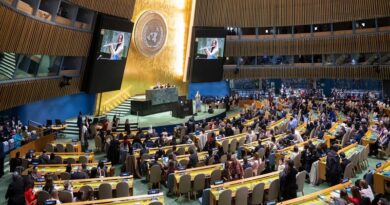Baku Dialogue promotes integrated climate, water action
Picture caption: WMO Secretary-General Celeste Saulo at the high-level meeting of the Baku Dialogue on Water and Climate Action at COP30 in Belém, Brazil.
How can you manage a dam, a flood, or a hydroelectric plant if you have no information or data? You can’t. You are blind to the risks to lives, livelihoods and economies.
These were the opening words of WMO Secretary-General Celeste Saulo at the high-level meeting of the Baku Dialogue on Water and Climate Action at COP30 in Belém, Brazil.
The Baku Dialogue was launched at COP29 in 2024 as a platform promoting collaboration and initiatives that address water challenges and accelerate solutions for the water crisis. The Dialogue aims to ensure a consistent focus on water and its interplay with climate change, biodiversity loss, pollution, and desertification, and focuses on actions at international, regional, and river basin levels.
“Water is too important to drop in and out of the climate agenda. The Baku Dialogue ensures that water is given the attention it has long deserves,” COP 29 President told the event on 11 November which was jointly hosted with the COP30 Presidency and supported by WMO, the UN Environment Programme (UNEP) and the UN Economic Commission for Europe (UNECE).
Nicola Speranza, Chief of Staff to the COP 30 President, called for renewed multilateralism and for connecting water issues to people’s daily lives, identifying finance and capacity building as “the key to success.”
Under the Baku Dialogue framework, WMO is responsible for science-based support to advance water for climate action.
“The World Meteorological Organization’s always insists that we cannot manage what we do not measure. And this applies to both climate and to water. Data – and data sharing – is more important today than ever. And to achieve this we need better water data, water observation and information systems,” Celeste Saulo told the event.
“The cost of investment may seem high. But it is – literally – a drop in the ocean compared to the costs of a flooding event, of a long-lasting drought, or of the construction of a new dam,” she said.
WMO’s State of Global Water Resources 2024 report shows that the water cycle is becoming more unpredictable. Too much or too little – and at the wrong time or in the wrong place.
This has a cascading impact on economies and ecosystems, on key sectors like agriculture and energy, and – of course on public health and safety. This is why WMO’s top initiative – Early Warnings for All – places such priority on water.
“We now face the challenge of managing not just rivers on the ground – but atmospheric rivers in the sky. How can we do that? Even as a scientist, I have no ready answer,” said Celeste Saulo.
“And what about the water towers of the world? Our iconic glaciers which are retreating, and which bring so many short-term hazards and threaten so much long-time water insecurity,” she said.
In addition to discussing the challenges, the high-level event also examined the opportunities such as Artificial Intelligence, which is already supporting hydrological work across the value cycle — from monitoring to data management to modeling and forecasting.
Stefan Uhlenbrook, WMO Director, Hydrology, Water and Cryosphere emphasized WMO’s science-based support to help countries understand the status and outlook of their water resources, and improve preparedness, resilience, and recovery in response to water-related hazards.
WMO initiatives include:
The Hydrological Status and Outlook System, which will provide information and forecasts at global, regional and basin level. This seeks to strengthen countries’ capacities to understand the status and outlook of water resources across the hydrological value chain);
WMO’s World Water Data Initiative aims at improving data collection and sharing to help in conserving, protecting, restoring and sustainably managing water resources, basins, and water-related ecosystems.
Early Warnings For All: supports interested countries in improving preparedness, prevention, resilience and recovery in response to water-related hazards and disasters.
State of water and climate monitoring: Disseminate and utilize basin-wide climate scenarios, and climate risk and vulnerability assessments related to water resources.
Ministers and high-level speakers at the event stressed the importance of ensuring that water considerations are integrated into national climate action and adaptation planning, as well as for transboundary and river-basin cooperation.




